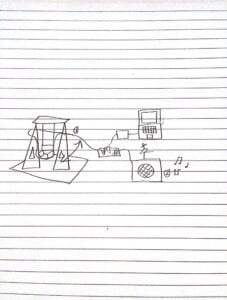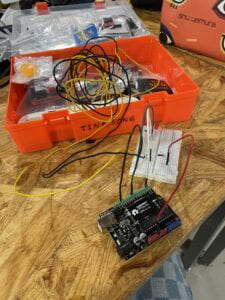A. Back to Summer Nostalgia – Victoria Chen – Rudi

B. Our previous group research project was a helmet that cured depression among the population. The helmet was connected to helping others lift to a place of positive emotions. I really liked the concept of making people happier, so for the midterm project, Tina and I decided to base our ideas on spreading happiness or positive emotions. In regards to research, we looked at music boxes triggered by different sensors and pianos that were built into different systems. It triggered our definition of interaction: defining a typical object in a different way that allows the user to interpret in their own ways. What was unique about our project was that we recreated a light box that allowed the user to experience a happy nostalgic feeling. Additionally, the light was installed in an icecream truck to heighten the emotions of childhood and was turned on and off in a different way. Rather than having a regular switch, we created a swing switch so the user can interact with the design better. Our projects puts night lights or light boxes in a new light, a more interactive and happy light. Lastly, the project was created for people who have grown up, chasing ice cream trucks in the summer, and miss how happy they were back then. The project brings them back to happy memories and valuable thoughts and emotions.


C. We definitely wanted the swing since it reminded a lot of people of childhood, and decided that an icecream truck was also very nostalgic. The area that we weren’t entirely sure with was how the user should interact with the swing. To attack this problem, we decided to conduct an user experience test with our friends and classmates. We asked several to put their hands on the swing as if they were the person in the swing, and also asked several to put a figure in the swing and push it. As a result, we found that having the users put their hands on the swing was more interactive as they pictured themselves in the swings. However, we still made little figures just incase a user is persistent on putting a figure in the swing. Additionally, we used pipe cleaners and cotton balls to decorate our project as they were also a prominent part of many’s childhoods. We were originally going to paint the cardboard, but we didn’t think it would present as effectively to the audience.



Code (credits to https://arduinointro.com/projects/tilt-sensor-with-arduino-easy-tutorial)
//Read the value of a tilt sensor
int tiltsensor = 2;
void setup()
{
pinMode(tiltsensor, INPUT);
//initialize communication at 9600 bits per second
Serial.begin(9600);
}
void loop()
{
//print the value on the serial monitor
//Go to Tools->Serial Monitor to see the values
Serial.println(digitalRead(tiltsensor));
delay(100);
}



D. We started our project really late in the timeline, so we ended up having a whole bunch of ideas and not a lot of action. We had solid, creative ideas, however, we did not know how to code it, or our ideas were too complicated. As a result, we were behind on schedule, and we did not know exactly what we were going to do until after the practice round of presentations on the Friday before the actual presentation. We used our classmates’ and teachers’ critiques to come up with a design that we really liked. Before finalizing the project and piecing it together, we conducted a user testing session that consisted of our classmates and friends testing out how they liked to active the product with the swing. Initially, we were going to use figurines for the users to push on in the swing, but after the testing session, we decided to have the users put their hands on the swing and push it as if they were in the swing themselves. This change was effective and highlighted our LED lights in the icecream truck better. Additionally, in the last minute, we decided to add clay over the LED lights to make the design more interactive. The lights would act as lit up ice cream rather than just the lights on the truck. It is as if the memories in someone’s head is lighting up because of our project.



E. Our project’s initial goals were to create positive feelings as a result of the interactive of our design. More specifically, our project created the feeling of summer nostalgia. This result aligns with my definition of interaction due to the personal communication the user and the ice cream truck has: the user is able to control how the light is lit up through the swing and is able to decide to leave it on as a night light or play with it as a fidget toy. Additionally, the projects triggers different variations of memories in each person, no memory is the same, therefore the communication between the user and the light-up truck aligns with my definition of interaction. However, our ice-cream truck is not as effective in communicating with the user. It might take the user a while to understand the workings of our LED lights and how to activate it (pushing it slowly or quickly), thus lowering the effectiveness of our project results and not aligning with my definition of interaction. On the day of the presentation, the audience ended up pushing the swing by the edge rather than placing her hand on the swing and moving it up and down. It was not to our expectation that she would do that, but our project still worked. If we had more time, we would add music that went with the ice-cream truck as well as a more sensitive sensor which will communicate more effectively with the user. From our setbacks in the beginning of the project process, I learned to start early and do more research, and to not be afraid to ask for assistance. From our accomplishments, I learned how to effectively present a project as well as understanding that what comes with hard work is satisfaction of the outcome. Both Tina and I loved our results for our project.
